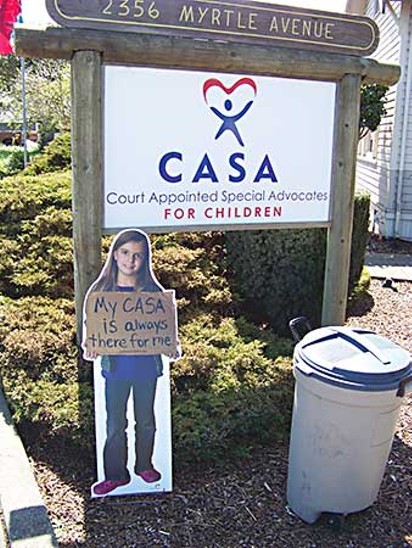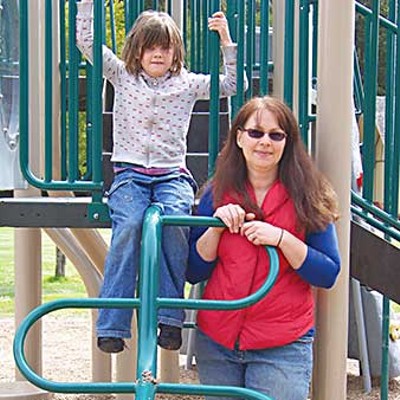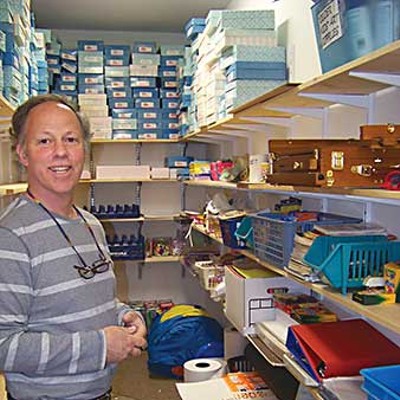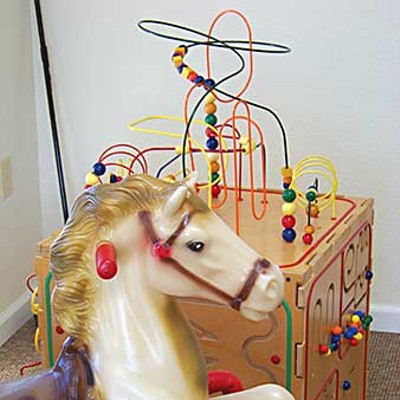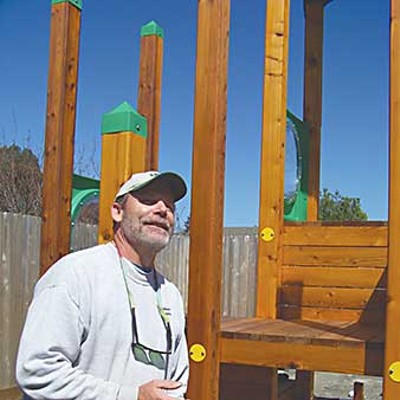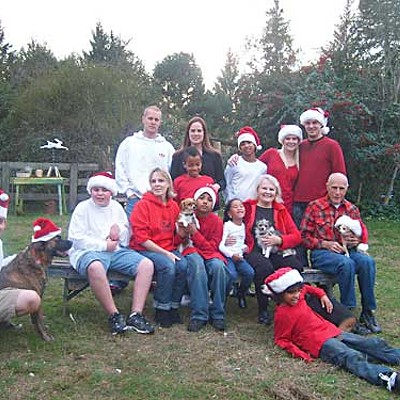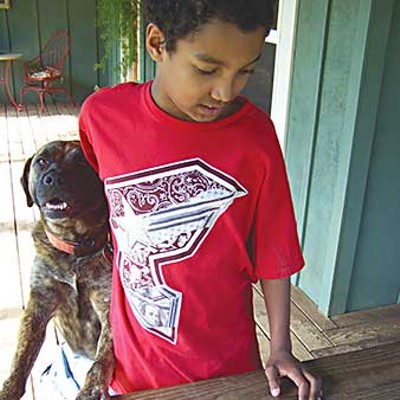The CASA
A legally appointed buddy can help a kid move forward when life seems to have lurched to a stop
By Heidi Walters[
{
"name": "Top Stories Video Pair",
"insertPoint": "7",
"component": "17087298",
"parentWrapperClass": "fdn-ads-inline-content-block",
"requiredCountToDisplay": "1"
}
]
This Saturday, CASA of Humboldt will throw open the doors of its newly remodeled and expanded headquarters on Myrtle Avenue and invite everyone in to examine what is essentially a haven of beauty, comfort, stimulation and light. "CASA" stands for "court-appointed special advocate" -- a trained volunteer who is the friend, and voice, of a child caught up in the juvenile dependency court system. Often, these kids are victims of abuse or neglect and have been removed from their homes. And it can seem as if a million different people are coming and going, trying to sort out their young lives. A CASA volunteer is the constant in such a kid's life.
Now, the support system for the CASA volunteers -- there are about 60 of them in Humboldt -- has become more stable, as well, with the establishment of a permanent home for the nonprofit organization. After five years of toil and fundraising, the nonprofit's recently paid-off, 1928-vintage house and garage have been transformed into a single place of spacious walls and floor space, big windows, tidy offices, well-supplied kitchen, stuffed leather couches, abundant art supplies, toys and games and a freshly constructed playground in a side yard -- and most of that great stuff was donated by various entities in the community or acquired through grants.
Now, CASA of Humboldt can begin to dream bigger, says executive director Steve Volow. Imagine art classes in the airy main room where the rocking horse sits. Yoga classes. Volunteer trainings in the conference room. Cooking lessons. Team meetings of parents, advocates and social workers. And advocates already are using the new space to meet with their kids: One guy helped his appointed child with some math the other day; another advocate did a yoga session with her child.
And maybe, now, CASA can recruit more volunteers, and perhaps hire another supervisor to help them.
But just what, exactly, does a CASA do? And why is that so important?
[][][]
Time for another bathroom break.
"Mom!" cried Micah, who will be 4 in June. "Mommy!"
Yes, Micah answered his mom, he did go pee when they all trooped to the bathroom together 15 minutes ago. But now he had to poop. Crystal Davis called out to her other kids scattered about on playground equipment this sunny midmorning at Rohner Park, in Fortuna, and once again everyone made the trek to the bathrooms.
Along the way, they passed a group picnic area and Sam, who with his twin, Jack, will be 5 in August, became mesmerized by the whining leafblower that a tatted-up park employee was waving around the picnic tables and benches. Davis called him, and he tore himself away to rejoin the group. At the bathrooms, the twins went into the boys' side and began yipping like coyotes and faking loud fart noises to make the most of the echoey walls. Davis, Micah and 8-year-old Hailey disappeared chattily into the other side.
Eventually, they all emerged -- but Sam ran back into both bathrooms, and then ran outside and stared up at the roof of the building to watch the two gleaming vent covers spin, then ran back inside to check out where they went.
"Sam picked the lock on our filing cabinet with a paperclip when he was just 2 1/2," said Davis, smiling. "He's our high mechanic -- that, and music, and a late talker; they say all three go together."
Davis and her husband, Randy, have seven still-at-home kids: one biological son, Dawson, and six adopted children -- well, actually, one is still officially a foster child, but the Davises expect the adoption to go through any day now. The Davises adopted Sam and Jack on Jan. 23, 2006, when they were 13 months old, after fostering them since they were 9 days old. On the same day they also adopted Micah, who was 3 months old and had already been in two foster homes, and who was one of a batch of baby boys at the time who couldn't find homes because, apparently, everyone wanted girls. Hailey and her big brother, Bailey -- who was off somewhere else with a friend this day -- came into Crystal and Randy Davis' life as foster children in May 2007, after 18 months with another foster parent; the Davises adopted them on Aug. 27, 2008.
Including most of the adopted kids, 25 kids have lived with the Davises as foster children -- some just for a few days, some longer. So the Davises have worked with a number of CASAs. "They all deserve an award," said Crystal.
Back at the playground, the kids dispersed: Jack to bellyflop over the swing to repeatedly wind it up and let it unravel fast, the ground spinning under his nose; Sam to race on the treadmill with the squirrels carved in the plastic barrel; Micah to scuff his feet through the woodchips of the play area and tag after his siblings; and Hailey to alternately swing from the monkey bars and sit at the table to listen to her mom talk to a reporter. Hailey, who has blue eyes, freckles and soft-looking straight brown hair, finally got the reporter to herself, with her mom's permission.
"I want to tell you a story," she said. "I used to live with my grandma because my mother couldn't take care of me because she did drugs. Sometimes, my grandma would take me to my aunt's, and my cousins were really nice to me -- one of them gave me piggyback rides. After awhile, I was with my dad, and my dad came and brang me to a store to buy beer for himself, and then the cops saw him and he got arrested. And then I came to a different place."
That place was a foster home. And there, said Hailey, the lady taking care of her got mad one day and put her in a cold shower. "I told my CASA, and that's how I came here," she said, looking around at her adoptive family. She added, quietly and matter-of-factly, "I had a hard life when I was younger."
And now? Now, she said, she likes living in Hydesville with her adoptive family and all of their pets and all that space to run around in. "It just seems funner, now that I'm older," said Hailey.
"Mom!" yelled Sam, dancing on the treadmill. And then Jack, from over on the swings: "Mommy!" Now, in stereo: "Mommy!!"
Time for another bathroom break.
[][][]
On another mid-April morning, inside the newly expanded and renovated CASA headquarters, in Eureka, Steve Volow showed off the revamped, expanded CASA digs. The main entry retains the core of the old house, with its intricate, agate-inlaid hearth intact. Volow, who's been the executive director since 1999, has hung on the walls a half-dozen prints of Native American children, including some of photographs taken by Edward S. Curtis at the turn of the last century. Volow said that, while Native Americans represent about 6 percent of the Humboldt population, they make up 25 to 30 percent of the foster care population. (The Yurok, Hoopa Valley and Karuk tribes have started their own dependency courts, and are establishing their own CASA programs; so far there's some overlap still with Volow's program). So he wants to make the place especially welcoming.
Down the hall, which connects to what used to be the separate garage, are staff offices as well as the roomy kitchen with a shiny new stove donated by the Co-op and a pile of new, washed pots gleaming on the drainboard. Here, CASAs can teach their kids how to cook, Volow said. The hall spills into a large, friendly room with couches and windows. Here and elsewhere, artist Linda Parkinson has hung dozens of her paintings -- it's a bright gallery space upon which Volow hopes to entice other artists to display their work. He opened closets to show all the toys, art supplies and educational materials people have donated. Out the back door, there's a playground that Frank Janowski, a local home builder as well as CASA volunteer, was finishing constructing free of charge.
Back inside, Volow spread out on a couch an array of dentist appointment notification cards with colorful paintings printed on one side. Look closely, and you can see that some of the card art has been signed by Bailey, some by Hailey, and some by other kid artists. In fact, Bailey and Hailey Davis take art classes from Volow's wife, Trina Massion -- and Massion herself is a CASA. Volow said his nonprofit organization hopes to market the cards to more dental offices -- so far, two are using them -- in order to raise more money. That's one of the new projects that's hopefully taking off, he said.
"Hope" seems to permeate this place, with its window-lit interior and the inherent sense of promise in all of its newness. But the heart of all this hope really comes from the 60-some volunteer court-appointed special advocates, the CASAs, whom Volow's team trains and coordinates. These CASAs work with about 80 children a year, said Volow, who is the organization's second director. CASA of Humboldt was started in 1991 and first run by Valerie Bish. Forty percent of CASA of Humboldt's funding is provided by two grants, one as a line-item in the state budget and another from the Humboldt County court system; the remaining 60 percent comes from fundraising.
The CASA program is national. But it started out as a localized pilot program in Seattle in 1977, after a Seattle Superior Court Judge, David Soukup, realized that amid the criminal and civil cases he dealt with that involved child victims of abuse and neglect, he really wasn't learning enough about the kids themselves and what their needs were. The concept spread, became a formalized national association in 1982, and in 1989 the American Bar Association embraced the use of CASA volunteers. Then the Victims of Child Abuse Act of 1990 mandated that every child who's been a victim of abuse or neglect should have a CASA if needed.
The CASA volunteer fulfills two key roles: First, the CASA is the appointed child's friend through the time that the child's life is entangled in court, and as such is required to meet with the child two or more hours a week and, in general, hang out and have fun or maybe work on some homework or just talk. Two, the CASA is the child's voice in court -- in that role, the CASA is a fact-finder and must investigate the case. That can mean researching court, medical and school records, for instance, and interviewing everyone involved: social workers, birth parents, teachers, foster parents and so on. Then, with a CASA supervisor, the CASA regularly presents a formal report to the judge that provides a personal, intimately informed picture of the child's wants, needs and goals.
"Sometimes the advocates, these volunteers, make the difference in a child's life that had seemed doomed," said Volow. "So that's incredible to watch."
Many CASAs work full time, as well -- something that amazes Volow and his staff, he said, because they see how much work most CASAs put into working on their child's case. CASAs must pass a background check and be fingerprinted, undergo 30 hours of training initially, and take 12 additional hours of continuing education each year. They file monthly reports with the court, meet with others involved in the case, and go to court hearings -- although a CASA supervisor also goes to hearings and can present the CASA's report.
Usually, said Volow, a child ends up in the foster-care system after someone -- a nurse or a teacher, perhaps, or maybe a friend or neighbor -- notices that a child appears to be abused or neglected and makes a report to law enforcement or to the county social services department. From there, several things can happen, all geared to make the child safe: One, if the allegation of abuse or neglect is determined to be unsubstantiated but it appears the parents need some assistance, the county directs them to vountary services; two, if the abuse or neglect is confirmed but it seems that, with help, the parents can make changes to improve the child's safety, Child Welfare Services helps the family do that; and three, if Child Welfare Services determines that the child's not safe at home, another arrangement is found.
The latter cases end up in juvenile dependency court, and usually the children enter the foster care system -- which can mean living with another relative, an appointed guardian or with a foster family (if the child is a Native American, he or she must be placed within a culturally appropriate home). And everybody gets a lawyer -- the child, the parents, the social worker, the guardian or foster parents -- and more hearings commence.
The whole intent of the court proceedings is to move the child out of the court system as quickly as possible, said Judge Christopher Wilson, who presides over Humboldt County Family Court, at the Courthouse last Friday. The preferred scenario, he said, is to reunify the children with their parents within sixth months, or longer if necessary. But if reunification is not ultimately possible, then the child must be moved into a permanent situation -- either with a permanent guardian or through adoption. (Volow said only about 30 percent of the cases end in reunification, even though most start out with that being offered as an option to the birth parents. Stats from the Humboldt County Department of Health and Human Services indicate that of the 171 children in foster care last year, 37 percent were reunified with their families the same year; 28 percent were adopted. The rest, presumably, remain in the system.)
"The really important aspect of this is, what are this child's lifetime connections that are going to sustain this child for the long-term?" said Wilson.
But the court process can take months, sometimes years. And during that time, the child may experience a whirlwind of social workers, attorneys and foster homes, with the faces changing every few months, perhaps.
The CASA may end up being the one constant in the child's life, the one who is there for the child from beginning to end, until he or she is permanently placed. That's essential for the child's peace of mind. But it also provides continuity in a case.
"Every child is that snowflake we have to treat differently, that we have to see as an individual," said Wilson. "That's where CASA comes in. ... The CASA's role is to view the whole dependency process from the child's perspective. And [the CASA's reports] let me see the case from that child's perspective. And what I usually see from a CASA's report is this child's goals in life."
So the CASA is the child's main advocate, but also supplements everyone else, filling in the blanks and taking some of the investigative workload off of social worker, foster parent and attorney alike.
CASA of Humboldt ends up working with about a third of the 200-some (on average) children in the foster care system each year, said Volow, back at the new digs on Myrtle Avenue.
"Most of the cases we deal with, the birth parents are not engaged," Volow said. "But the times the parents are involved and trying to get their children back, I'll try and match that family with a CASA."
[][][]
Jan Carr had a case like that. Carr, 54, lives in a big, gracious, extremely neat home on a farm she bought two years ago, just off West End Road in Arcata. There, she is mom to seven adopted children between the ages of 6 and 14, and 56 animals -- including nine noisy running ducks, 11 dogs, 23 cats, mini donkeys, llamas, pigeons and doves, all rescued from the pound or brought to her to care for. Carr also has three adult biological children, who've long been on their own; they, and her own parents, often help her out with the kids. Otherwise, she notes, she does everything without help, other than what social services a couple of her special needs children require.
On a warm afternoon last week, only two kids were kicking about the farm: Angela, 12, and Michael, 11, half of a sibling group of four that Carr adopted eight years ago. The rest were off doing different things, although they'd all probably agree that 8-year-old Romeo was on the most exotic adventure at the moment -- he was away at an acting academy in Sacramento, where he's been going regularly since a Hollywood talent scout spotted him goofing around, dancing and acting up, at a Jonas Brothers concert. But all the kids play sports, some dance -- Angela just placed second at a dance competition in Sacramento -- and some also play music, said Carr. And they all sing in the choir.
"I think it's important to expose them to everything," Carr said, sitting at the picnic table on her porch. Five of the dogs lined up in a diagonal behind a low gate confining them to the back yard, watching Carr's visitor quietly and wagging their tails. One, a heeler mix the kids named "Fragile," eventually leaped lightly over the gate and bounded onto the table to greet the visitor.
Things started out much more simply for Carr.
"In 1997, my youngest daughter was going to college and I was having empty nest syndrome," Carr said. So, she decided to become a CASA. After training, she was assigned to a 3-year-old girl. Unlike most cases CASAs see, Carr said, there was no drug abuse involved. The girl's mom was mentally ill, and simply couldn't care for her. Carr said the mother was combative with her at first, not knowing whom she could trust.
"It was really difficult for me, because I knew how desperately she loved that child," said Carr. "But, ultimately, the judge decided it wasn't safe for the girl to live with her. It was hard for me, especially as a mother. I still get very emotional when I think about it."
The girl was adopted, and now lives back east.
Carr decided she wanted to do more, so she trained to be a foster parent. That segued into becoming an adoptive parent.
"I remember being 16 years old, in high school, and I wanted to do something with animals," Carr said. "I had this vision I would get this big warehouse and fill it with all the strays. It took me 50 years to get a place like this. I just wanted an oasis where animals and kids could live peacefully."
While she no longer is a CASA, Carr still does speaking engagements for the organization and supports it financially. She remembers vividly, and gratefully, many of the CASAs who helped with her kids -- but especially the two who helped with her adopted sons Bradley and David, a sibling pair who came to her first to be fostered.
"Because of Bradley and David's case, CASA is near and dear to my heart," Carr said.
About 10 years ago, Bradley and David were removed from their family in what Carr describes as "a high-profile case." Bradley, who was 3 at the time, had recently suffered a brain injury from abuse, and David, who was 5, had witnessed it. The parents went to prison for child abuse, and Bradley spent four months in Oakland's Children's Hospital. The boys were soon assigned to Carr for foster care, the day after she had completed her foster parent training. Bradley, because of his injury, had two CASAs.
"Jerry was unforgettable," said Carr. "He was a retired hospital administrator, and he drove a green convertible BMW sportscar. Bradley just thought he was, wow. Jerry would pick him up and take him to Pierson's to watch the goldfish. Their lives were very chaotic. At one time, I had 29 people involved in these boys' lives -- counselors, teachers, occupational therapists, lawyers ... It was crazy, and that went on for two years. So I really appreciated Jerry coming along and taking the kids away to do peaceful things. Sometimes he'd take David out to eat."
The other CASA, Kathy, wrote all the reports. "When you have a juvenile case, everyone except the foster parent has an agenda, and everyone is getting paid," said Carr. "CASA is the only one that isn't getting paid. They're volunteer. They're objective. And I felt it was crucial to have someone report to the judge who was objective.
"I can't say enough about the importance of CASA in these kids lives."
[][][]
CASA of Humboldt's Open House is from 1 p.m. to 4 p.m. this Saturday, April 25, at 2356 Myrtle Ave. And they're always looking for more volunteers: 443-3197.
Comments
Showing 1-1 of 1
more from the author
-
From the Journal Archives: When the Waters Rose in 1964
- Dec 26, 2019
-
Bigfoot Gets Real
- Feb 20, 2015
-
Lincoln's Hearse
- Feb 19, 2015
- More »
Latest in News
Readers also liked…
-
Through Mark Larson's Lens
A local photographer's favorite images of 2022 in Humboldt
- Jan 5, 2023
-
'To Celebrate Our Sovereignty'
Yurok Tribe to host gathering honoring 'ultimate river warrior' on the anniversary of the U.S. Supreme Court ruling that changed everything
- Jun 8, 2023
